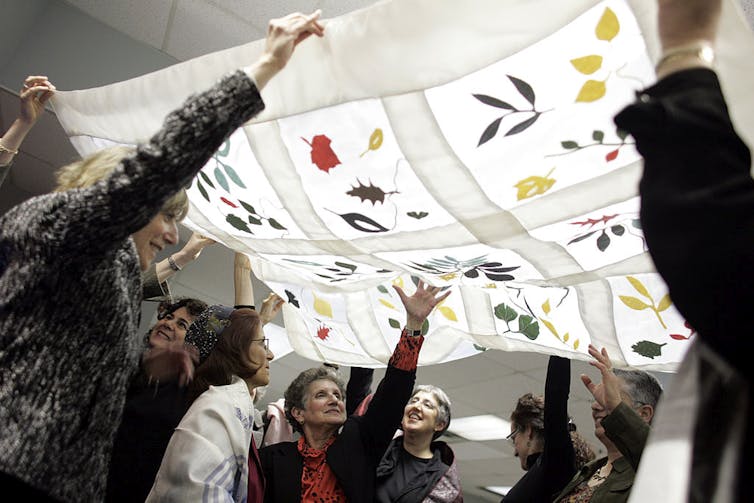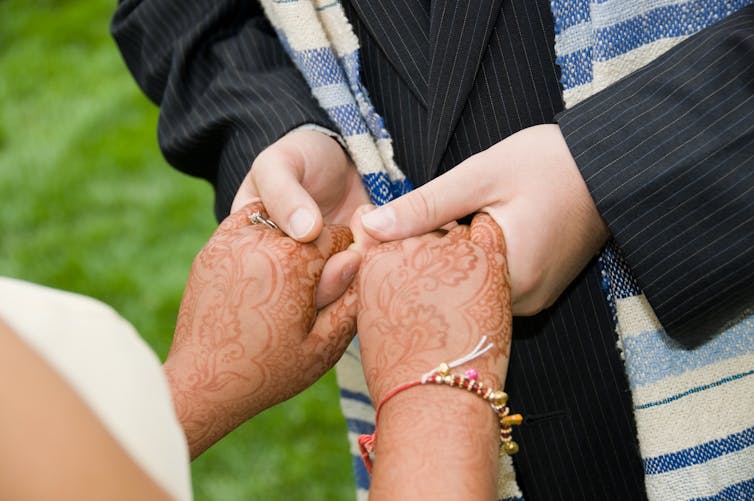More than 10 years ago, I attended a college friend’s wedding in New York City.
My friend is Muslim, her husband Jewish. They were married under a Jewish wedding canopy made from the groom’s bar mitzvah prayer shawl – which, his mother announced to the assembled guests, had been made in India, the bride’s parents’ country of origin. The bride wore a red wedding sari. The groom’s mother read and explained the seven blessings of a Jewish wedding; the bride’s mother read from the Quran and then provided an English translation.
The bride and groom sipped from the same cup of wine, as one does at a Jewish wedding. But knowing that I was writing about her wedding for my book on interfaith marriages, the bride pulled me aside in between the ceremony and the photos. They had replaced the traditional wine with white grape juice, she told me – nonalcoholic in deference to the fact that she is Muslim; white out of fear of staining the wedding finery before the photos.
My friend’s interfaith wedding might seem unusual, but it is part of the American Jewish normal. Approximately 42% of married Jews have a spouse who is not Jewish. Among American Jews who have gotten married since 2010, that percentage rises to 61%.
Many advocates for interfaith families prefer not to call these marriages between Jews and “non-Jews,” because that term defines people by what they are not – erasing their own vibrant religious and cultural heritage. There is great diversity in whom Jews marry. Most spouses come from Christian backgrounds, given the demographics of the United States, but Christianity itself is very diverse. Others marry Hindus, Muslims, Buddhists or people from any number of other religious traditions.
In my research on interfaith families, I’ve seen ceremonies combine traditions in a wide array of ways.
A meaningful canopy
Sometimes the Jewish wedding canopy, called a chuppah, is simply a beautiful piece of cloth, or combined with floral arrangements. Often, though, it represents family traditions. A bride or groom might use the same chuppah as their parents, use a family prayer shawl, or have a chuppah that combines fabric from both of their mothers’ wedding dresses.

At interfaith ceremonies, the chuppah is often a way to weave another culture into the wedding. When Jews marry people from India – be they Hindu, Muslim, Christian, Buddhist or even another Jew – they will sometimes use a sari or a shawl with distinctively Indian embroidery to make the wedding canopy.
Another couple that I wrote about in “Beyond Chrismukkah,” a book based on my research on Jewish-Christian families, made the chuppah out of an African American story quilt that they then hung over their bed, with the intent that they would add a square for every year of their marriage. The last square that they added depicts two people standing together: her pregnant and him beaming. They laughingly told me that life got busy after the baby was born, and they are now over two decades behind.
Still another bride and groom made a chuppah decorated with symbols, some of which represented them as individuals, and others narrating what brought them together as a couple. Their design included a Star of David for him and a flaming chalice, the symbol of the Unitarian Universalist Association, for her, and then the love of books and hiking that they shared.
Getting creative
While many rabbis are not allowed to formally co-officiate with clergy from other religions at weddings, some are able to do so.
Other rabbis allow another clergy person to offer a reading or take another role in the ceremony – sometimes to picturesque effect. At one wedding, a Catholic Franciscan friar offered a blessing in his brown robe and sandals, standing under a chuppah next to a rabbi wrapped in a Jewish prayer shawl.
No matter who performs the ceremony, couples often find creative ways to incorporate their traditions into the wedding day. Many pull readings from both of their traditions: some meaningful commentary on marriage, or even the famous biblical verse I Corinthians 13: “Love is patient, love is kind.” Jewish-Hindu couples may pair the seven Jewish wedding blessings with the seven steps taken in a Hindu wedding.
Some couples have a Jewish ceremony but make other parts of their heritage a central part of the celebration: inviting a Christian relative to say grace before the supper, for example, or greeting guests at the reception venue with a Hindu aarti, in which one of the hosts will wave trays of lighted lamps in front of the guests to show them honor, respect and blessing. Often, families will include food from the non-Jewish culture, whether it’s elaborate Italian American dinners or Chinese wedding banquets.
Other interfaith couples will surround their Jewish wedding day with traditions from the non-Jewish culture. For instance, Jewish brides traditionally visit a ritual bath called a mikveh before their weddings. Some brides in Jewish-Hindu interfaith weddings follow the trip to the mikveh with a mehendi party and ladies’ sangeet: a night of henna painting and singing.

Tough conversations
Not everything is fun and easy in the world of interfaith weddings. More and more rabbis in the more liberal Reform, Reconstructionist and Renewal movements perform interfaith ceremonies. In August 2023, however, the Conservative movement reaffirmed its ban on Conservative rabbis performing interfaith marriages.
During my research on interfaith families, couples told me many, many stories about their weddings – even though, in the end, I was not really writing about weddings. Sometimes, the stories were hard. One bride’s childhood rabbi refused to perform the ceremony, angering her parents so much that they quit their synagogue of 30 years. Some couples expressed pain about grandparents or aunts and uncles who skipped the ceremony. In one case, a woman expressed relief that her father had died before her nephew announced his engagement. She was glad that her father never said to his grandson what he had said to her when she fell in love with a Protestant.
Overall, however, most people’s weddings were happy memories that offered hints to the interfaith lives and household that they would go on to create together.

